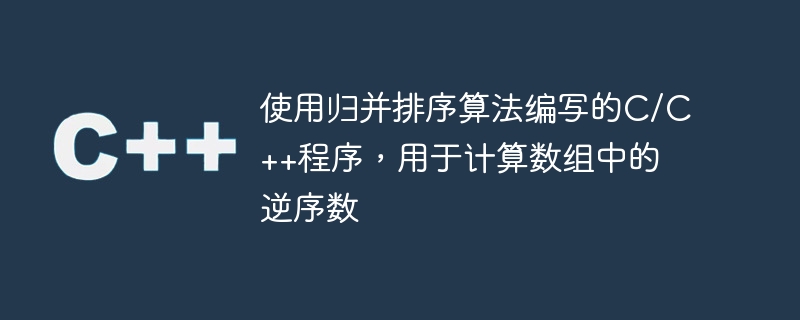

The reversed representation of an array; how many changes are required to convert the array into its sorted form. When the array is already sorted, 0 reversals are required, while in other cases, if the array is reversed, the maximum number of reversals will be achieved.
In order to solve this problem, we will follow the merge sort method to reduce the time complexity and use the divide and conquer algorithm.
A sequence of numbers. (1, 5, 6, 4, 20).
The number of reversals required to sort the numbers in ascending order.
Here the number of inversions are 2. First inversion: (1, 5, 4, 6, 20) Second inversion: (1, 4, 5, 6, 20)
Input - Two arrays, who have been merged, left, Right and middle index.
Output - Arrays merged in sorted order.
Begin
i := left, j := mid, k := right
count := 0
while i <= mid -1 and j <= right, do
if array[i] <= array[j], then
tempArray[k] := array[i]
increase i and k by 1
else
tempArray[k] := array[j]
increase j and k by 1
count := count + (mid - i)
done
while left part of the array has some extra element, do
tempArray[k] := array[i]
increase i and k by 1
done
while right part of the array has some extra element, do
tempArray[k] := array[j]
increase j and k by 1
done
return count
EndInput - Given an array and a temporary array, the left and right indices of the array.
Output -The number of reverse-ordered pairs after sorting.
Begin
count := 0
if right > left, then
mid := (right + left)/2
count := mergeSort(array, tempArray, left, mid)
count := count + mergeSort(array, tempArray, mid+1, right)
count := count + merge(array, tempArray, left, mid+1, right)
return count
EndReal-time demonstration
#include <iostream>
using namespace std;
int merge(int arr[], int temp[], int left, int mid, int right) {
int i, j, k;
int count = 0;
i = left; //i to locate first array location
j = mid; //i to locate second array location
k = left; //i to locate merged array location
while ((i <= mid - 1) && (j <= right)) {
if (arr[i] <= arr[j]){ //when left item is less than right item
temp[k++] = arr[i++];
} else {
temp[k++] = arr[j++];
count += (mid - i); //find how many convertion is performed
}
}
while (i <= mid - 1) //if first list has remaining item, add them in the list
temp[k++] = arr[i++];
while (j <= right) //if second list has remaining item, add them in the list
temp[k++] = arr[j++];
for (i=left; i <= right; i++)
arr[i] = temp[i]; //store temp Array to main array
return count;
}
int mergeSort(int arr[], int temp[], int left, int right){
int mid, count = 0;
if (right > left) {
mid = (right + left)/2; //find mid index of the array
count = mergeSort(arr, temp, left, mid); //merge sort left sub array
count += mergeSort(arr, temp, mid+1, right); //merge sort right sub array
count += merge(arr, temp, left, mid+1, right); //merge two sub arrays
}
return count;
}
int arrInversion(int arr[], int n) {
int temp[n];
return mergeSort(arr, temp, 0, n - 1);
}
int main() {
int arr[] = {1, 5, 6, 4, 20};
int n = 5;
cout << "Number of inversions are "<< arrInversion(arr, n);
}Number of inversions are 2
The above is the detailed content of C/C++ program written using the merge sort algorithm to calculate reverse numbers in an array. For more information, please follow other related articles on the PHP Chinese website!
 Vue parent component calls the method of child component
Vue parent component calls the method of child component
 What is digital currency trading
What is digital currency trading
 How to use fusioncharts.js
How to use fusioncharts.js
 length function usage
length function usage
 Cost-effectiveness analysis of learning python, java and c++
Cost-effectiveness analysis of learning python, java and c++
 Representation method of string constant
Representation method of string constant
 mysql transaction isolation level
mysql transaction isolation level
 How to open .dat files
How to open .dat files
 how to build a website
how to build a website




